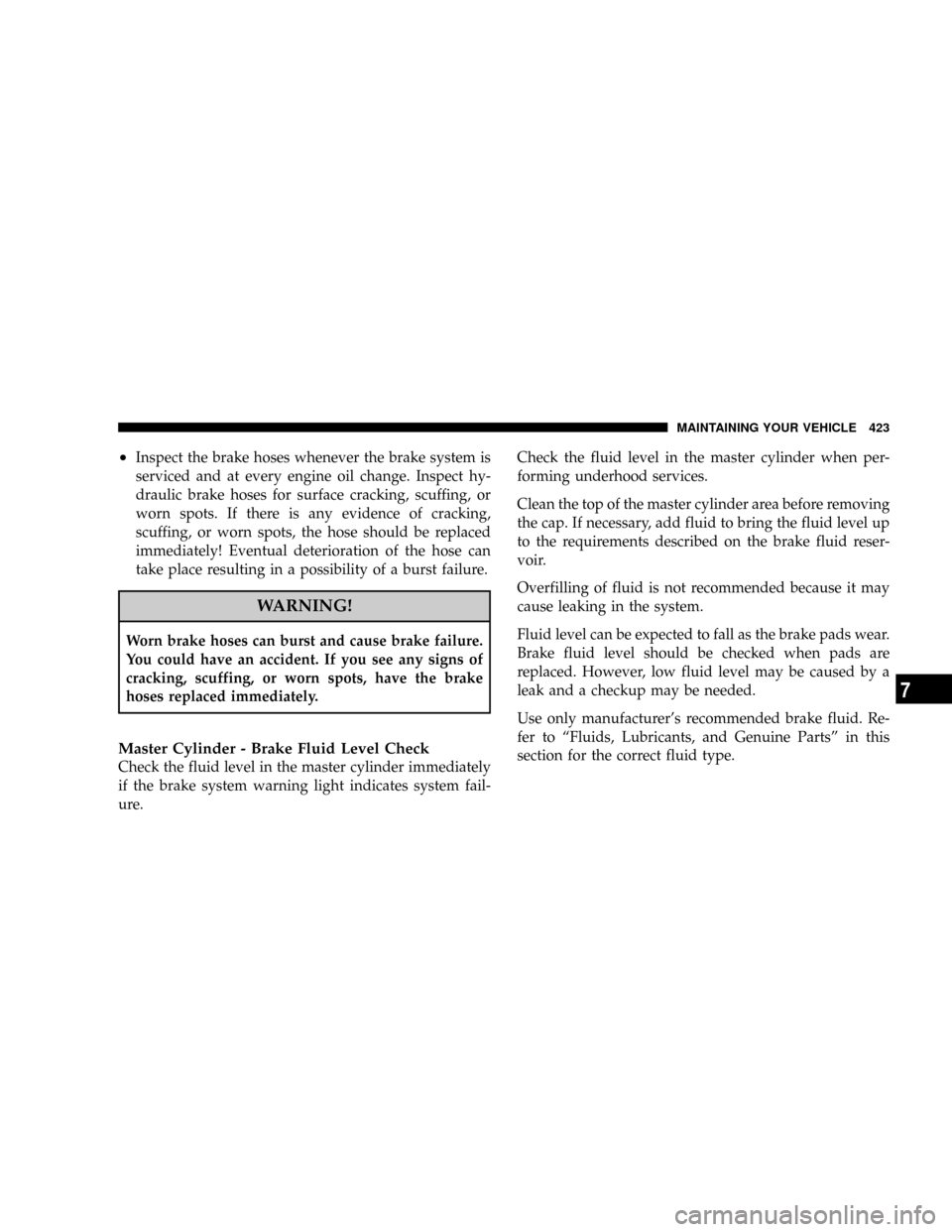Page 380 of 493

3. Turn the ignition switch to the ON position.
4. Depress the brake pedal.
5. Shift the transmission to ªNº (Neutral) (automatic
transmission), or depress the clutch pedal (manual trans-
mission).
6. Use the point of a ballpoint pen or similar object to
depress the recessed transfer case Neutral (N) button for
4 seconds. After the shift is complete, and the Neutral (N)
light turns on, release the Neutral (N) button.
7. Start the engine.
8. Shift the automatic transmission into ªRº (Reverse).
9. Release the brake pedal for five seconds and ensure
that there is no vehicle movement.
10. Repeat Steps 8 and 9 with the transmission in ªDº
(Drive) (automatic transmission) or 1st gear (manual
transmission).11. Shut OFF the engine.
12. Turn the ignition switch to the unlocked OFF posi-
tion.
13. Shift the transmission into ªPº (Park) (automatic
transmission), or shift into 4th gear (manual transmis-
sion).
14. Attach the vehicle to a tow vehicle with a tow bar.
15. Disconnect the battery negative cable.
NOTE:
²Steps 1 through 5 are requirements for shifting the
transfer case. If these requirements are not met prior to
depressing the Neutral (N) selection button or while
the shift attempt is in process, then the Neutral (N)
indicator light will flash continuously until all require-
ments are met or until the Neutral (N) button is
released.
380 STARTING AND OPERATING
Page 381 of 493

²The ignition switch must be in the ON position for a
shift to take place and for the position indicator lights
to be operable. If the ignition switch is not in the ON
position, the shift will not take place and no position
indicator lights will be on or flashing.
²Flashing Neutral (N) position indicator light indicates
that shift requirements have not been met.
CAUTION!
Damage to the transmission may occur if the trans-
mission is shifted into ªPº (Park) with the transfer
case in Neutral (N) and the engine RUNNING. With
the transfer case in Neutral (N), ensure that the
engine is OFF prior to shifting the transmission into
ªPº (Park).
Shifting Out of Neutral (N)
Perform the following procedure to prepare your vehicle
for normal usage:
1. Bring the vehicle to a complete stop.
2. Reconnect the battery negative cable.
3. Place the ignition switch in the LOCK position (if it
has been moved or the engine has been started).
4. Turn the ignition switch to the ON position, but do not
start the engine.
5. Depress the brake pedal.
6. Shift the transmission into ªNº (Neutral) (automatic
transmission), or depress the clutch pedal (manual trans-
mission).
7. Use the point of a ballpoint pen or similar object to
depress the recessed transfer case Neutral (N) button.
Release the Neutral (N) button after the Neutral (N)
STARTING AND OPERATING 381
5
Page 382 of 493

indicator light turns off (approximately 1 second). After
the Neutral (N) button is released, the transfer case will
shift to the position identified by the selector switch.
8. Start the engine.
9. Shift the transmission into ªDº (Drive) (automatic
transmission) or into 1st gear and momentarily release
the clutch (manual transmission) to verify that the trans-
fer case has engaged.
10. Set the parking brake.
11. Shift the transmission into ªPº (Park) (automatic
transmission), or into ªNº (Neutral) (manual transmis-
sion).NOTE:
²Steps 1 through 6 are requirements for shifting the
transfer case. If these requirements not met prior to
depressing the Neutral (N) selection button or while
the shift attempt is in process, then all of the mode
position indicator lights will flash continuously until
all requirements are met or until the Neutral (N)
button is released.
²The ignition switch must be in the ON position for a
shift to take place and for the position indicator lights
to be operable. If the ignition switch in not in the ON
position, the shift will not take place and no position
indicator lights will be on or flashing.
²Flashing Neutral (N) position indicator light indicates
that shift requirements have not been met.
382 STARTING AND OPERATING
Page 423 of 493

²Inspect the brake hoses whenever the brake system is
serviced and at every engine oil change. Inspect hy-
draulic brake hoses for surface cracking, scuffing, or
worn spots. If there is any evidence of cracking,
scuffing, or worn spots, the hose should be replaced
immediately! Eventual deterioration of the hose can
take place resulting in a possibility of a burst failure.
WARNING!
Worn brake hoses can burst and cause brake failure.
You could have an accident. If you see any signs of
cracking, scuffing, or worn spots, have the brake
hoses replaced immediately.
Master Cylinder - Brake Fluid Level Check
Check the fluid level in the master cylinder immediately
if the brake system warning light indicates system fail-
ure.Check the fluid level in the master cylinder when per-
forming underhood services.
Clean the top of the master cylinder area before removing
the cap. If necessary, add fluid to bring the fluid level up
to the requirements described on the brake fluid reser-
voir.
Overfilling of fluid is not recommended because it may
cause leaking in the system.
Fluid level can be expected to fall as the brake pads wear.
Brake fluid level should be checked when pads are
replaced. However, low fluid level may be caused by a
leak and a checkup may be needed.
Use only manufacturer's recommended brake fluid. Re-
fer to ªFluids, Lubricants, and Genuine Partsº in this
section for the correct fluid type.
MAINTAINING YOUR VEHICLE 423
7
Page 442 of 493
Cavity Cartridge
FuseMini
FuseDescription
M37 Ð 10 Amp
RedAnti-Lock Brake Sys-
tem (ABS)/Electronic
Stability Program
(ESP) Module/Stop
Light Switch
M38 Ð 25 Amp
NaturalDoor & Liftgate
Lock/Unlock MotorsCAUTION!
²When installing the Integrated Power Module
cover, it is important to ensure the cover is prop-
erly positioned and fully latched. Failure to do so
may allow water to get into the Integrated Power
Module, and possibly result in an electrical system
failure.
²When replacing a blown fuse, it is important to
use only a fuse having the correct amperage rating.
The use of a fuse with a rating other than indicated
may result in a dangerous electrical system over-
load. If a properly rated fuse continues to blow, it
indicates a problem in the circuit that must be
corrected.
442 MAINTAINING YOUR VEHICLE
Page 454 of 493
Once a Month
²Check tire pressure and look for unusual wear or
damage.
²Inspect the battery and clean and tighten the terminals
as required.
²Check the fluid levels of coolant reservoir, brake
master cylinder, and power steering, and add as
needed.
²Check all lights and other electrical items for correct
operation.At Each Oil Change
²Change the engine oil filter.
²Inspect the brake hoses and lines.
²Check the manual transmission fluid level.
CAUTION!
Failure to perform the required maintenance items
may result in damage to the vehicle.
454 MAINTENANCE SCHEDULES
8
M
A
I
N
T
E
N
A
N
C
E
S
C
H
E
D
U
L
E
S
Page 470 of 493

About Your Brakes....................... 308
ABS (Anti-Lock Brake System).........195,310,315
Adding Engine Coolant (Antifreeze).......... 418
Adding Fuel........................... 359
Adding Rear Washer Fluid................. 181
Adding Washer Fluid..................145,181
Additives, Fuel......................... 357
Air Cleaner, Engine (Engine Air Cleaner Filter) . . . 406
Air Conditioner Maintenance............... 411
Air Conditioning........................ 260
Air Conditioning Controls................. 260
Air Conditioning Filter.................271,412
Air Conditioning, Operating Tips............ 272
Air Conditioning Refrigerant............. 411,412
Air Conditioning System.............260,264,411
Air Filter.............................. 406
Air Pressure, Tires....................190,338
Airbag................................ 52
Airbag Deployment....................... 64Airbag Light.......................67,81,204
Airbag Maintenance....................... 66
Alarm, Panic............................ 24
Alarm (Security Alarm).................18,204
Alarm System (Security Alarm)............... 18
Alignment and Balance................... 343
Alterations/Modifications, Vehicle............. 8
Antenna, Satellite Radio................... 255
Antifreeze (Engine Coolant)...........417,418,447
Disposal............................ 419
Anti-Lock Brake System (ABS)............310,315
Anti-Lock Warning Light.................. 195
Anti-Theft Security Alarm (Theft Alarm)........ 18
Anti-Theft System....................... 204
Appearance Care........................ 428
Arming Theft System (Security Alarm)......... 18
Assist, Hill Start........................ 319
Audio Systems (Radio).................... 237
Auto Down Power Windows................ 36
470 INDEX
Page 471 of 493

Auto Unlock, Doors....................... 32
Automatic Dimming Mirror................. 88
Automatic Door Locks...................31,32
Automatic Headlights.................... 134
Automatic Oil Change Indicator..........201,209
Automatic Temperature Control (ATC)......... 264
Automatic Transaxle
Special Additives...................... 425
Automatic Transmission................283,425
Adding Fluid......................425,449
Fluid and Filter Changes................. 425
Fluid Change......................... 425
Fluid Level Check...................... 425
Fluid Type........................... 449
Gear Ranges.......................... 283
Overdrive........................... 285
Special Additives...................... 425
Torque Converter...................... 287
Automatic Transmission Limp Home Mode..... 287Auxiliary Electrical Outlet (Power Outlet)...... 169
Auxiliary Power Outlet................... 169
Axle Fluid............................. 449
Axle Lubrication (Axle Fluid)............... 449
Battery............................... 409
Charging System Light.................. 194
Emergency Starting..................... 390
Gas Caution.......................... 410
Jump Starting......................... 390
Keyless Transmitter Replacement (RKE)....... 25
Belts, Drive............................ 406
Belts, Seat............................42,81
Body Mechanism Lubrication............... 413
B-Pillar Location........................ 333
Brake Assist System...................... 316
Brake Assist Warning Light................. 196
Brake Control System, Electronic............. 314
Brake Fluid............................ 449
INDEX 471
10